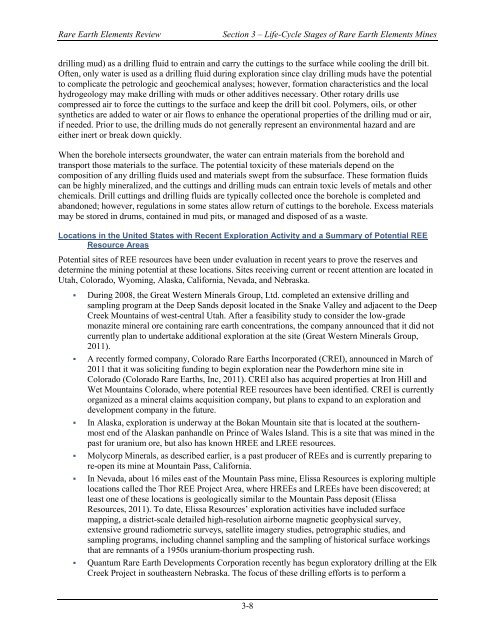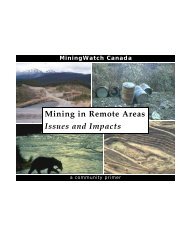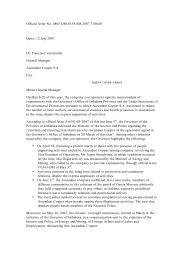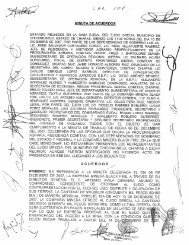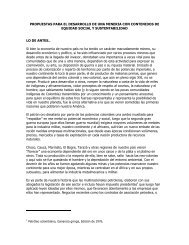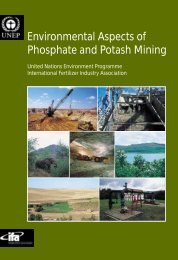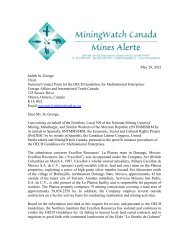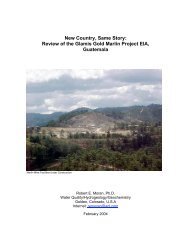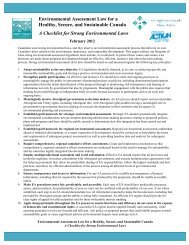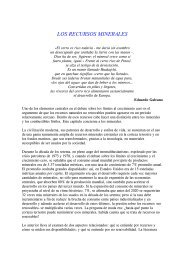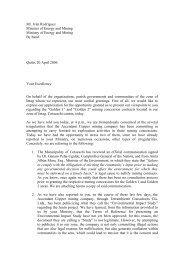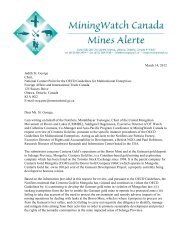Rare Earth Elements: A Review of Production, Processing ...
Rare Earth Elements: A Review of Production, Processing ...
Rare Earth Elements: A Review of Production, Processing ...
Create successful ePaper yourself
Turn your PDF publications into a flip-book with our unique Google optimized e-Paper software.
<strong>Rare</strong> <strong>Earth</strong> <strong>Elements</strong> <strong>Review</strong><br />
Section 3 – Life-Cycle Stages <strong>of</strong> <strong>Rare</strong> <strong>Earth</strong> <strong>Elements</strong> Mines<br />
drilling mud) as a drilling fluid to entrain and carry the cuttings to the surface while cooling the drill bit.<br />
Often, only water is used as a drilling fluid during exploration since clay drilling muds have the potential<br />
to complicate the petrologic and geochemical analyses; however, formation characteristics and the local<br />
hydrogeology may make drilling with muds or other additives necessary. Other rotary drills use<br />
compressed air to force the cuttings to the surface and keep the drill bit cool. Polymers, oils, or other<br />
synthetics are added to water or air flows to enhance the operational properties <strong>of</strong> the drilling mud or air,<br />
if needed. Prior to use, the drilling muds do not generally represent an environmental hazard and are<br />
either inert or break down quickly.<br />
When the borehole intersects groundwater, the water can entrain materials from the borehold and<br />
transport those materials to the surface. The potential toxicity <strong>of</strong> these materials depend on the<br />
composition <strong>of</strong> any drilling fluids used and materials swept from the subsurface. These formation fluids<br />
can be highly mineralized, and the cuttings and drilling muds can entrain toxic levels <strong>of</strong> metals and other<br />
chemicals. Drill cuttings and drilling fluids are typically collected once the borehole is completed and<br />
abandoned; however, regulations in some states allow return <strong>of</strong> cuttings to the borehole. Excess materials<br />
may be stored in drums, contained in mud pits, or managed and disposed <strong>of</strong> as a waste.<br />
Locations in the United States with Recent Exploration Activity and a Summary <strong>of</strong> Potential REE<br />
Resource Areas<br />
Potential sites <strong>of</strong> REE resources have been under evaluation in recent years to prove the reserves and<br />
determine the mining potential at these locations. Sites receiving current or recent attention are located in<br />
Utah, Colorado, Wyoming, Alaska, California, Nevada, and Nebraska.<br />
• During 2008, the Great Western Minerals Group, Ltd. completed an extensive drilling and<br />
sampling program at the Deep Sands deposit located in the Snake Valley and adjacent to the Deep<br />
Creek Mountains <strong>of</strong> west-central Utah. After a feasibility study to consider the low-grade<br />
monazite mineral ore containing rare earth concentrations, the company announced that it did not<br />
currently plan to undertake additional exploration at the site (Great Western Minerals Group,<br />
2011).<br />
• A recently formed company, Colorado <strong>Rare</strong> <strong>Earth</strong>s Incorporated (CREI), announced in March <strong>of</strong><br />
2011 that it was soliciting funding to begin exploration near the Powderhorn mine site in<br />
Colorado (Colorado <strong>Rare</strong> <strong>Earth</strong>s, Inc, 2011). CREI also has acquired properties at Iron Hill and<br />
Wet Mountains Colorado, where potential REE resources have been identified. CREI is currently<br />
organized as a mineral claims acquisition company, but plans to expand to an exploration and<br />
development company in the future.<br />
• In Alaska, exploration is underway at the Bokan Mountain site that is located at the southernmost<br />
end <strong>of</strong> the Alaskan panhandle on Prince <strong>of</strong> Wales Island. This is a site that was mined in the<br />
past for uranium ore, but also has known HREE and LREE resources.<br />
• Molycorp Minerals, as described earlier, is a past producer <strong>of</strong> REEs and is currently preparing to<br />
re-open its mine at Mountain Pass, California.<br />
• In Nevada, about 16 miles east <strong>of</strong> the Mountain Pass mine, Elissa Resources is exploring multiple<br />
locations called the Thor REE Project Area, where HREEs and LREEs have been discovered; at<br />
least one <strong>of</strong> these locations is geologically similar to the Mountain Pass deposit (Elissa<br />
Resources, 2011). To date, Elissa Resources’ exploration activities have included surface<br />
mapping, a district-scale detailed high-resolution airborne magnetic geophysical survey,<br />
extensive ground radiometric surveys, satellite imagery studies, petrographic studies, and<br />
sampling programs, including channel sampling and the sampling <strong>of</strong> historical surface workings<br />
that are remnants <strong>of</strong> a 1950s uranium-thorium prospecting rush.<br />
• Quantum <strong>Rare</strong> <strong>Earth</strong> Developments Corporation recently has begun exploratory drilling at the Elk<br />
Creek Project in southeastern Nebraska. The focus <strong>of</strong> these drilling efforts is to perform a<br />
3-8


